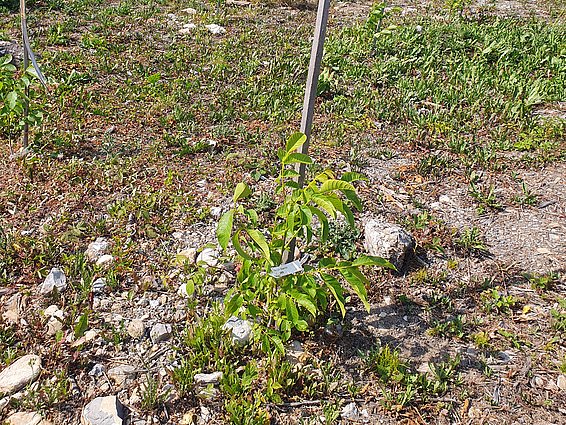Swiss common garden network of future tree species
2017 - 2038
Cooperation FinancingContents ¶
Between autumn 2020 and spring 2023 a network of common gardens of tree species adapted to future climate was established throughout Switzerland as a joined effort of the Federal Institute for Forest, Snow and Landscape Research (WSL), the Federal Office for the Environment (FOEN), cantonal forest services, forest managers, professional organizations and forest owners. The common gardens, consisting of 55.000 plants, will be monitored for several decades and allow insights in the suitability of tree species across broad environmental gradients in a changing climate. This network offers a unique infrastructure for practitioners as well as researchers and we are open for collaborations.



Latest news ¶
Current work on the sites
In fall 2025, an inventory was carried out on all common garden sites. To date, mortality has been assessed three times on all areas (2023, 2024, and 2025) and the height of all plants has been measured once (2024 or 2025). For the most part, the plants have established well. The results were compiled for an article in the Swiss Journal of Forestry, which will be published in March 2026. The current measurements of the climate stations can be viewed on our Grafana portal.
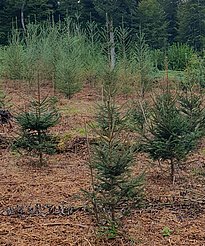
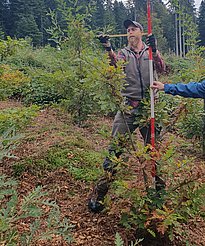
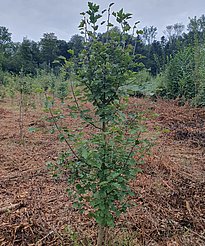
New publications from the project ¶
In 2024, we provided information on the design of and process towards the Swiss common garden network in a scientific publication and in an implementation article and placed the network in the context of similar experiments across Europe. We also published the initial results of the 2023 mortality survey in an implementation article.We provide our partners with a standard presentation and a brochure for their communication activities. In March 2026, a publication will appear in the Swiss Journal of Forestry, explaining the results of the mortality inventories for 2023 and 2024.
New projects that use the Swiss common garden network ¶
The network is used by reserach projects to answer their own research questions. In 2024 and 2025, the interactions between the soil communities and six of our deciduous tree species were investigated on several sites. The Root Traits Strategies Project is led by Gemma Rutten from the University of Bern. To find out more about soil biodiversity, we took soil cores from 15 sites in 2025 under fir trees, sycamore maples, sessile oaks, Turkey oaks, and Douglas firs.
Background ¶
A warmer climate with drier summers will affect the climatic suitability of tree species in their current habitat, and, subsequently, future ecosystem services provided by our forests. In many forest stands other tree species than those currently occurring at a given site will grow better towards the end of the 21st century. While some tree species are already growing on sites where the future climate is supposed to suit them, others are currently still absent from them.
In this context foresters are exposed to the following question:
Which of the tree species supposedly adapted to the climate expected on a given site towards the end of the 21st century can already establish and grow there today?
To find answers to this question the project ‘Swiss common garden network of tree species adapted to future climates’ was started. Within its scope a network of 56 common gardens was established throughout Switzerland. Planted trees will be monitored over 30-50 years to find answers to pressing issues in climate change adaptation. The project will allow verification of results of the research program ‘Forests and climate change’. Its results will help the validation of site-specific tree species recommendations for forest practitioners, and it will create a long-term infrastructure for applied research. The scientific question behind the project is: which factors determine mortality, health and growth of tree species and provenances along large environmental gradients?
The great advantage of this project is the coordinated approach. While a single plantation provides only answers for the specific site, the network allows comprehensive and robust statements on the performance of tree species along large environmental gradients. Thus, this long-term trial will improve our understanding of effects of climate and climatic extremes on the trees species and provenances under investigation. The project is a follow-up activity of the research program "Forest and Climate Change", which FOEN and WSL conducted from 2009 to 2018.
Tree species ¶
The tested tree species were selected taking into account considerations of cantonal stakeholders and experts in a multistage procedure. While nine tree species belonging to the core set will be planted at approximately 35 sites, another nine tree species belonging to the extension set will be planted at only approximately 15 sites. The process of tree species selection is reported in ‘Tree species selection for Swiss common gardens’ (only available in German and French).
The 18 tree species under investigation comprise many of the species which are probably suitable in future climates. For tree species of the core set reliable results will be generated to analyze and compare their performance over a broad environmental gradient, while for tree species of the extension set the explanatory power will be smaller.
| Core set (9 tree species) | Ergänzungsset (9 Arten) |
|---|---|
| Abies alba (silver fir) Acer pseudoplatanus (Sycamore maple) Fagus sylvatica (European beech) Larix decidua (European larch) Picea abies (Norway spruce) Pinus sylvestris (Scots Pine) Pseudotsuga menziesii (Douglas fir) Quercus petraea (Sessile oak) Tilia cordata (Small-leaved Lime) | Acer opalus (Italian maple) Acer platanoides (Norway maple) Cedrus atlantica (Atlas ceda) Corylus colurna (Turkish hazel) Juglans regia (Persian walnut) Prunus avium (Wild cherry) Quercus cerris (Turkey oak) Quercus robur (Pedunculate oak) Sorbus torminalis (Wild service tree) |
Provenances ¶
For each tree species seven provenances are tested. In order to keep the size of the common gardens manageable only four out of the seven provenances are assigned to each plantation. While six provenances will be tested in half of the common gardens only, one provenance will be tested as reference in all common gardens a species is assigned to. This allows for better coverage of the genetic variability within the tree species, while it keeps site sizes manageable.
The provenances were selected in an elaborate process (report ‘Provenance selection and seedling provisioning’). The plant material was procured in cooperation with several Swiss nurseries and foreign partners. Most of the plants are grown at the Emme AG nursery, a few tree species are also grown at the nursery of the Canton of Ticino (Morbio Superiore) and at the WSL experimental nursery.
Design ¶
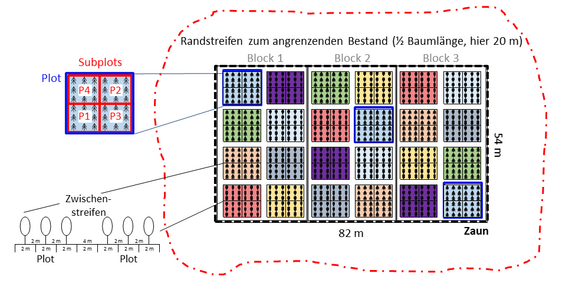
All common gardens are consistent in their design which allows reliable statistical analyses. The experimental design includes both the distribution of tree species over the common gardens and the arrangement of plants within each site. The design has been worked out in collaboration with researchers and was revised by external statisticians. The 56 common gardens are distributed over all biogeographic regions and altitudinal belts occurring in Switzerland. Every common garden is split into three blocks. The blocks are split in as many plots as there are tree species assigned to a specific site. All tree species will be planted once in every block and assigned randomly to a plot within the block. The number of tree species tested per site and therefore the number of plots and the size of the plantation is variable. Each plot is split into four subplots to which four provenances per tree species are assigned randomly. Finally, every subplot contains nine individual trees.
The area needed for a common garden is given by the number of tree species assigned to this site and by the height of the neighboring stands, which determines the width of the buffer zone needed. The spacing between plants is 2 m, and between plots 4 m. The area needed for a common garden with 4 tree species is approximately 0.75 ha. A plantation with 10 tree species requires approximately 1.3 ha.
To record the local climate, an automated climate station is operated on each experimental site. It measures among other things soil moisture.
Detailed information about the experimental design can be found in the report ‘Versuchsdesign für Testpflanzungen’ (available in German and French only).
Experimental sites ¶
In mid-March 2018, the cantons have been invited to propose experimental sites which are meeting the requirements described in the report ‘Site selection for common gardens’ (only available in German and French). From November 2018 to July 2019, the WSL project team visited 125 of the 172 sites proposed by the cantonal forest services. In July 2019, 57 sites were selected and the tree species to be tested on each site were assigned (report `Site selection for common gardens’ (only available in German and French). Prior to establishment, changes were made to the selection of sites and the allocation of tree species. Two additional trial sites were added in the canton of Baselland, while two sites had to be deleted in the canton of Bern. Unfortunately, another trial site in the canton of Geneva had to be abandoned in 2024. The site was severely affected by waterlogging and the plants died and could not be replanted. The network now includes 56 trial plots.
All common gardens are contractually secured in the long term.
The 57 common gardens are distributed over all biogeographic regions and altitudinal belts occurring in Switzerland. Depending on site size, four to 18 tree species are tested in a common garden. On six sites (‘supersites’), all 18 tree species are tested.
Table of all common gardens sorted by number.
Number TS = Number of tree species tested on site
Planting period = Planting period in which the site is established
1 means fall 20 to spring 21, 2 means fall 21 to spring 22, 3 means fall 22 to spring 23.
| No. | Canton | Municipality | Locality | Number TS | PP | Month | Year |
| 1 | AI | Schwende | Berneregg | 6 | 1 | May | 21 |
| 4 | GR | Safiental | Gampel | 5 | 2 | Sept | 21 |
| 9 | ZH | Oberrieden | Neuforst | 6 | 1 | Mar | 21 |
| 10 | LU | Emmen | Oberschiltwald | 6 | 3 | Nov | 22 |
| 11 | LU | Pfaffnau | Birchwald | 6 | 3 | Mar | 23 |
| 15 | LU | Escholzmatt-Marbach | Buhhütte | 10 | 1 | May | 21 |
| 16 | GR | Val Müstair | Cuoir | 10 | 2 | May | 22 |
| 17 | GR | Bregaglia | Dre Mota | 7 | 1 | Oct | 20 |
| 18 | GR | Valsot | Vadrain | 6 | 3 | Oct | 22 |
| 22 | GR | Samedan | Sur Plaun God | 8 | 2 | May | 22 |
| 25 | FR | Bulle | La Joretta | 8 | 1 | Oct | 20 |
| 26 | FR | Belmont-Broye | Forêt du Grand Belmont | 8 | 1 | Nov | 20 |
| 28 | SZ | Schwyz | Galleren | 8 | 2 | May | 22 |
| 36 | SZ | Feusisberg | Friesisschwand | 8 | 2 | Apr | 22 |
| 37 | GR | Albula/Alvra | Tgavrouls | 6 | 3 | ||
| 38 | GR | Bergün Filisur | Spena | 8 | 1 | Sep | 20 |
| 42 | AG | Villigen | Güllenholz | 8 | 3 | Nov | 22 |
| 43 | AG | Murgenthal | Fätzholz | 6 | 3 | Mar | 23 |
| 45 | SO | Seewen | Holzenberg | 6 | 3 | Nov | 22 |
| 47 | SO | Luterbach | Dorn-Ischlag | 8 | 1 | Nov | 20 |
| 48 | SO | Himmelried | Steffenschmiede | 8 | 2 | Nov | 21 |
| 51 | SH | Schaffhausen | Rändli | 18 | 3 | Oct | 22 |
| 54 | ZH | Aesch (ZH) | Seegaden | 4 | 2 | Nov | 21 |
| 66 | BL | Arisdorf | Eileten | 18 | 2 | Nov | 21 |
| 68 | SG | Gaiserwald | Hoferst | 8 | 2 | Mar | 22 |
| 72 | SG | Quarten | Oberer Nüchen | 6 | 1 | May | 21 |
| 74 | SG | Amden | Vorem Platt | 6 | 3 | Sep | 22 |
| 80 | SG | Uznach | Chrüzweg | 8 | 1 | Nov | 20 |
| 82 | VD | Froideville | Jorat d'Echallens | 10 | 1 | Nov | 20 |
| 85 | VD | Apples | Bois de Saint Pierre | 18 | 2 | Mar | 22 |
| 87 | VD | Vallorbe | Crêt Cantin | 8 | 3 | Mar | 23 |
| 91 | VD | Château-d'Oex | Les Jeurs | 10 | 2 | Sept | 21 |
| 93 | VS | Riederalp | Riederwald | 6 | 2 | Sept | 21 |
| 96 | VS | Riddes | Forêt des Conches | 8 | 1 | Dec | 21 |
| 97 | VS | Champéry | La Forêt Derrière | 8 | 3 | Oct | 22 |
| 99 | VS | Leuk | Baronsächer | 6 | 3 | Oct | 22 |
| 100 | VS | Bagnes | Forêt du Marais | 6 | 2 | Sept | 21 |
| 101 | TG | Ermatingen | Hauptmeshööli | 10 | 2 | Mar | 22 |
| 105 | TI | Serravalle | Caslóu | 7 | 2 | Mar | 22 |
| 108 | TI | Losone | Piano di Arbigo | 6 | 2 | Nov | 21 |
| 109 | TI | Ronco sopra Ascona | Casone | 12 | 3 | Oct | 22 |
| 118 | TI | Stabio | Baragge | 4 | 2 | Nov | 21 |
| 119 | TI | Novaggio | Ur Pián Pülpit | 10 | 1 | Mar | 21 |
| 124 | UR | Unterschächen | Alt Rüti | 8 | 3 | May | 23 |
| 129 | BE | Neuenegg | Ruessemattbode | 18 | 1 | Oct | 20 |
| 131 | BE | Rüschegg | Hirschböde | 6 | 1 | May | 21 |
| 156 | BE | Grandval | La Haute Joux | 18 | 2 | Apr | 22 |
| 162 | BE | Boltigen | Bäderegg | 5 | 2 | May | 22 |
| 166 | BL | Muttenz | Oberi Hard | 6 | 1 | Nov | 20 |
| 167 | JU | Haute-Ajoie | Foirgeret | 8 | 2 | Nov | 21 |
| 168 | GR | Maienfeld | Fuchsenwinkel | 18 | 2 | Oct | 21 |
| 170 | ZG | Unterägeri | Hinterwidenwald | 8 | 2 | Oct | 21 |
| 172 | ZH | Zürich | Waldlabor | 8 | 1 | Mar | 21 |
| 173 | TI | Locarno | Cappelletta | 10 | 3 | Mar | 23 |
| 174 | BL | Buus | Schöönenberg | 12 | 1 | Jan | 21 |
| 175 | BL | Pfeffingen | Bielgrabe | 8 | 2 | Mar | 22 |
Funding ¶
The establishment and maintenance of the common gardens is partly financed by subsidies from the Federal Office for the Environment. In addition, the cantons contribute significantly to the financing of their own experimental plantation sites.
Projects that use the Swiss common garden network ¶
Projects use the network to answer their own research questions. In the foil tunnel experiment, six tree species are exposed to heat and drought treatments on three of our sites. This experiment is led by Barbara Moser and artificially extends the climatic gradient on which the tree species are tested to include the warm-dry area. In addition, the clearing of the old stands from six of our sites served the Swiss Biomass Project under the direction of Esther Thürig, in which a calculation of biomass and carbon content in Swiss forests is conducted.


